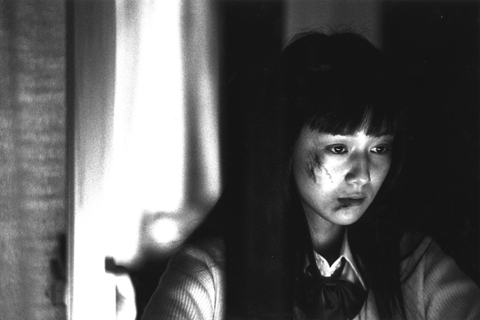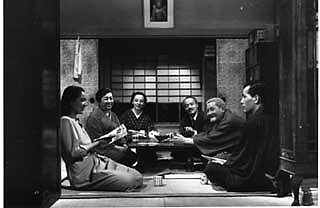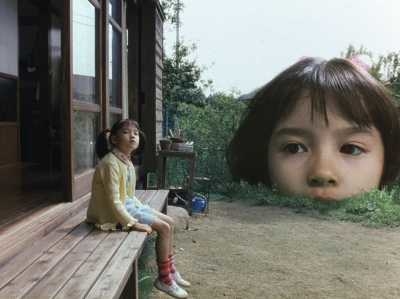Japan – mysterious country, full of ancient temples, dark forests and strange customs, has attracted visitors and soulseekers over centuries. The Dutch-Japanese relation, however, has dominantly been of a mercantile nature. As opposed to the Portugese who had to leave the country because of their missionary activities in 1587, the Dutch had no such interests and where more interested in trading. After regulations on foreign influences were severed in 1859, Dejima became the point of departure for a lot of Dutch people to explore the rest of the Japanese mainland. The island's name remains the most persistent symbol of the Japanese-Dutch relations.
Reason enough to name the first Japanese film festival in the Netherlands after this symbolic spot. More a showcase than a festival Dejima showed 8 Japanese productions from 2004. According to the organizers, Rob van Ham and Luc Lafleur, the focus was on previously unscreened films to differentiate the festival from bigger showreels like the IFFR in Rotterdam or the AFFF in Amsterdam which regularly include Japanese productions in their wider program.
What then is the Japanese film today? Are there heirs to the classical Japanese cinema of the 30's (Kenji Mizoguchi) and the 50's (Yasuhiro Ozu, Akira Kurozawa)? Is their a Japanese style of filmmaking?
Body – Slash – Future – Slash
In the panel discussion on Saturday these questions were debated between Tom Mes of Midnight.eye.com, Luk van Haute, cinephile and author of Revival van de Japanse film, Ivo Smits, lecturer at the University of Leiden and Gert-Jan Zuilhof, programmer at the IFFR. Luk van Haute emphasized that there is no unique Japanese style of narration or cinematography. The appeal of Japanese filmmakers is rather due to their inventiveness with handling small budgets. Using all available resources (Actors holding their own microphone, etc), engaging a vast network of friends for (post-) production makes films from Japan intricate and engaging pieces. As Takeshi Kitano put it once: "For the price of the animation of the flying feather in Forrest Gump I could make a whole film."
Tom Mes pointed out that Japanese film could be analysed in terms of the history of the studio system, which has affected the possibilities for newcomer filmmakers. With a reemerging sense of cinematographic identity, the differentiation from Hollywood can be grasped through a difference in means of production and distribution. Films like Casshern and Howl's Moving Castle operate with large budgets for production and publicity, geared towards an international audience. But they can help to engage people with more artistic and stylistically more interesting works by newcomers.
Japanese film suffers from a range of prejudices, being mostly associated with anime and horror films. Undoubtedly, the circles of Anime fans around the world have supported the circulation of other Japanese films. But besides anime, there are films in the tradition of Japanese and European art cinema, which deserve attention for their sometimes uncompromising and consequent artistic concepts, which feature single characters lost in isolation and in struggle with an atomized civil society.
Japanese films are almost always a Life and Death affair. People die either by their own will, or by a gang of raging yakuza or by accident ("Whoops, Sorry!"). The monsters in Horror films are ghosts from the world of the dead, getting back on the living. It is remarkable how often people die either by their own will or by the hand of others. But compared with the Hollywood mass slaughters and ubiquitous extras falling from high railings in blazing explosions, Japanese characters die with a story.
The dead and the living
Shintoism assumes that the world of the living and the dead coexist simultaneously. The dead are watching over the fate of the living. On the other hand, not only humans but every living thing (grassleaf, bug, bird) is bestowed with a soul. In the Industrial Age the anthropomorphized environment includes such fads as mobiles, Aibo and Tamagotchies. The Informational Age of advertising is writing the discourse of individualism through consumption of mass products. Looking at the films with these propositions in mind, the flap of the Butterfly's wing has unexpected effects.
The idea of individualism is fairly new to Japanese society. Respect for the elders and the family, group consent and the wider implications of an island identity have been reflected in classical films about ancient Japan by Mizoguchi and Kurozawa to the crumbling family structures in OZU's films. Dominant in these films is a blurring distinction between uchi (the own family, clan, ingroup) and soto (the others, outgroup). As historical markers of status are being replaced by income, consumption and business relations, these constitutive concepts loose their organizational function in society. Yakuza films can be interpreted as tales of the uchi-soto distinction, a rigid border between in- and outgroup and individuals fighting to get out (or in!).
With modernism progressing and social hierarchies crumbling, the interest of filmmakers has turned to those stories of individuals, which drop out of civil society out of various reasons. Interestingly, communication technologies which have been the backbone of Japanese economical success, are featured rarely in these films. Who wants a screen on a screen, anyway? It is rather an interest in unmediated communication, in technology becoming dysfunctional.
Lost in Communication
In Jyukai (Tomoyuki Takimoto, 2004) a yakuza loan shark, fully equipped with 4 mobile phones, gradually loses his track in the "Sea of Trees". A lonely ringtone in a vast forest finally leads him to his victim, who has already killed herself, leaving him alone in the wilderness, with an unuttered confession that he loved her. Two mobiles eternally calling each other without reply come to stand for two people lost within the boundaries of a forest (or Japanese society).
In his Rhomeresque piece Tony Takitani, Jun Ichikawa achieves an atmospheric density through close-ups of textures and shapes of endless rows of clothes, that the fashion addicted wife of Tony has left behind. Rather a communication tool than a protection from wind and weather, Ichikawa looks at the failure of fashion to replace the living person. What remains of the person when the clothes have disappeared? Is there more than façade and style? Or are these the only means we dispose of to make ourselves understood to the soto of ourselves?
Characters remain lonely in their search of identity, in their alliances with unequal partners (as in "L'Amant" by Ryuichi Hiroki), in their attempts to understand the adult world. Hirokazu Kore-Eda's film Nobody Knows released earlier this year featured a group of 4 kids who are abandoned by their mother. Unable to maintain a healthy life, they are left without perspective or means to change their situation. In its intimate and uncompromising portrayal, Kore-Eda speaks for the voiceless, unheard of people, who are steadily ignored by society.
In Katsuhito Ishii's satirical film "The Taste of Tea", the perspective of a young girl reveals the strange constellations of the adult world. Mainly a loose association of episodes, the main focus is the individuality of people's stories, their ambiguities and commitments. Seemingly an idealization of the 3-generation family, Ishii's film plays with distinctions of outside and inside the mind through anime-inspired insertions. A giant girl looking over the rooftop at its real-life double condenses the forlorn search for an inner self. The imagined self growing bigger and bigger, while the small child body remains helpless in the human made environment.
The real and imagined self
Japanese films are disturbing and amusing, juxtaposing the real and the imagined through inventive visual metaphors. At first sight it might seem like a revival of individual stories and drama, yet at the deeper level, these films are about disoriented people who have lost an uchi-soto distinction, who violate the group codes. This is as much a particularly Japanese phenomenon, as it is one of modern societies in general. Trying to locate the individual psychology in a thoroughly mediated environment seems to be the new stake of cinematic filmmaking. Generating images from computers, necessarily affects the film towards imagined, fantastic worlds. But using a camera to actually record an action, a scene, or a person still carries the impetus of a Bazinian "mummification", a preservation of a slice of real life.
Japanese filmmakers demonstrate that this preservation can be symbolically enlarged by combining filmed footage and animation. As opposed to other Asian nations, like Korea or India, Japanese films screened in Europe are less formulaic but follow idiosyncratic ways of screen composition and narration. They draw their inspiration from very local settings and backgrounds, yet tell universal stories of the modern man in a chaotic world. The pleasure of the text comes back to the cinema. Eventually, not every love story ends with a couple walking hand in hand into the sunset.
If you are looking for films from the land of the rising sun, Dejima is your point of departure.


